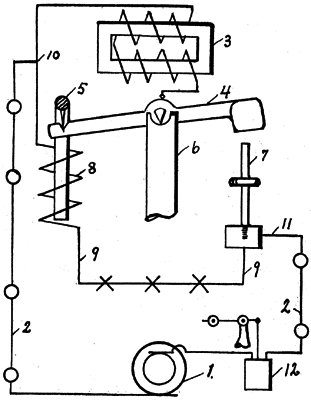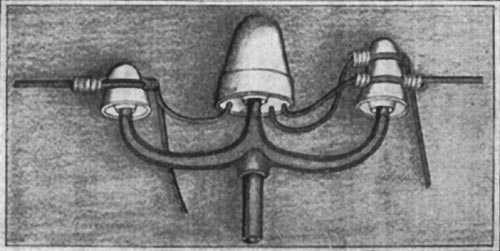[Trade Journal]
Publication: Western Electrician
Chicago, IL, United States
vol. 36, no. 5, p. 92, col. 1
Hamacek's Series Arc Cut-out.
One serious difficulty in the operation of series-arc lights is encountered in the breaking of loops leading to the lamps, which of course puts all the lamps in a series out of commission. A device for cutting out broken loops automatically without serious loss of current is now placed on the market by A. F, Hamacek of 2039 Kenmore Avenue, Chicago, and is illustrated herewith.
 |
| Fig. 1. Diagram of Connections of Series Arc Cut-Out. |
Fig. 1 is a diagram of the circuit. In this diagram (1) is the generator, (2) the series circuit, (o) any desirable number of lamps with the cut-outs in the circuit, (3) (4) (5) (6) (7) (8) the component parts of the cut-out and (9) (x) (x) (x) the local circuit. The lamps are represented by (x), of which there may be one or more in the circuit, to be controlled by the cut-out. In case any one of the lamps fails or the loops leading to it are parted the cut-out will automatically cut out the lamp and will again open when the circuit has been repaired.
The working of the cut-out is very simple, as shown in the sketch. The current enters at point (10) and divides, part going through the reactive coil (3) and part through the winding of the solenoid (8). When this has been done the solenoid pulls down the beam (4), which breaks the electrical contact between (4) and (7), or, respectively, between (10) and (11), thus putting the cut-out with the lamps directly into circuit. The dimensions of a cut-out with capacity to control one or two lamps are 5 1/4 by seven inches. The cap is removable from the base, it being merely slipped over the lower piece. The base screws on regular line pins, and when the cap is on, the whole presents the appearance of a good-sized insulator, as shown in Fig. 2, it being provided with the usual petticoats.
The next thing which may enter, into consideration is the loss that may arise by the use of the cut-outs. On alternating current when lamps run in series with regulators of reactance type there is said to be no loss at all, and a small gain may even be made which may be explained in this way: Referring to Fig. 1, (3) and (8) are really small reactance devices similar to the regulator at the station (12), and therefore when the cut-outs are on the circuit they produce part of the necessary reactance. The regulator at the station is therefore to that degree relieved and the loss in the regulator is reduced to a value approaching the copper loss only.
| |||
| Fig. 2. Cut-Out Mounted on Pin. |
In this cut-out the reactance coil (3) is out of the circuit when the lamp or lamps are in the circuit; but should the lamp be thrown out by means of open circuit, (3) is cut automatically into the circuit. In this latter event the reactance of (3) serves to compensate for the loss of resistance of the lamp and in that way relieves the stress on the regulator.

